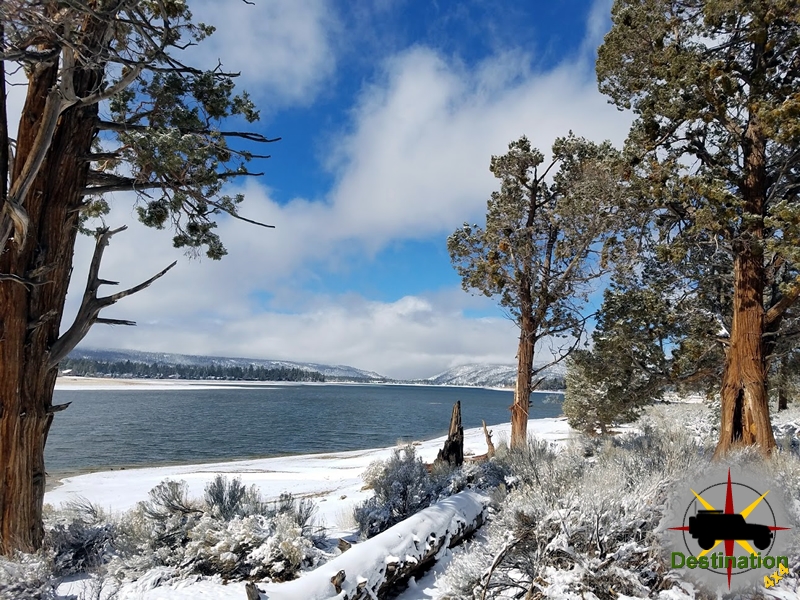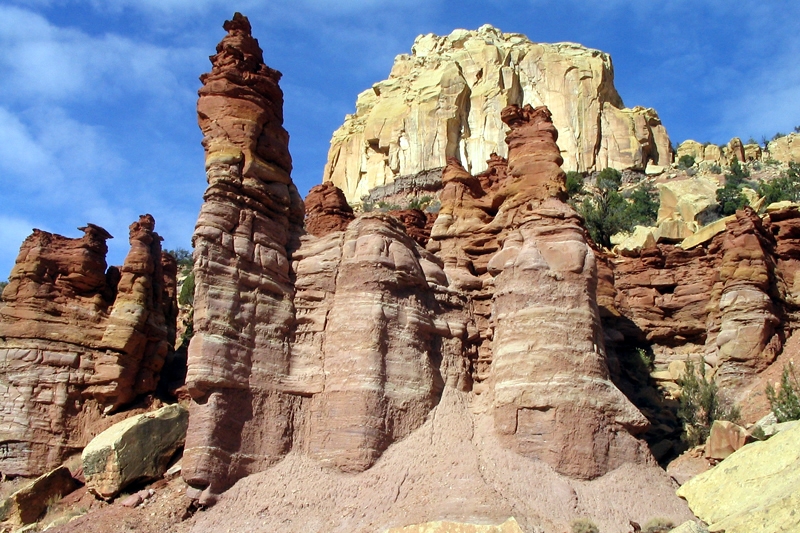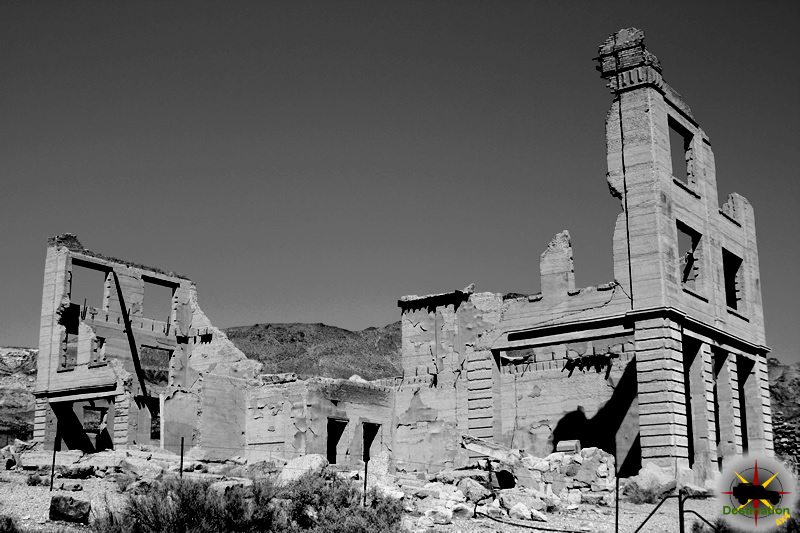
Old Boundary (Nevada’s Southern Boundary 1861-1867)
Old Boundary (Nevada’s Southern Boundary 1861-1867) is Nevada State Historical Marker number fifty seven located in Lincoln county, Nevada. The marker is located about 6 miles north of Beaty along highway 95.

In 1867, the Nevada Legislature approved the action of Congress to add that portion of the Territory of Arizona which lay to the south of this line, west of the 114 degree west longitude and the Colorado River, and to the east of the boundary of California. This action, taken on January 18, 1867, gave to the State of Nevada the permanent boundaries as they are today.
Nevada State Historical Markers identify significant places of interest in Nevada’s history. The Nevada State Legislature started the program in 1967 to bring the state’s heritage to the public’s attention with on-site markers. Budget cuts to the program caused the program to become dormant in 2009. Many of the markers are lost of damaged.
Nevada State Historic Marker 57
The 37th degree north latitude is marked at this point as the dividing line between the Territories of Utah and New Mexico under the provisions of the Compromise of 1850 which originally organized the land ceded by Mexico in 1848.
When the Territory of Nevada was carved from western Utah in 1861, this line became the southern boundary of the new territory and continued to serve as such when the Territory and State were enlarged by extensions to the east in 1862 and 1866 respectively.
In 1867, the Nevada Legislature approved the action of Congress to add that portion of the Territory of Arizona which lay to the south of this line, west of the 114 degree west longitude and the Colorado River, and to the east of the boundary of California. This action, taken on January 18, 1867, gave to the State of Nevada the permanent boundaries as they are today.
STATE HISTORICAL MARKER No. 58
STATE HISTORIC PRESERVATION OFFICE
Nevada State Historic Marker 57 Summary
| Nevada State Historic Marker | 57 |
| Name | Old Boundary (Nevada’s Southern Boundary 1861-1867) |
| Location | Lincoln County |
| Latitude, Longitude | 36.9772, -114.9771 |
Nevada State Historic Marker 57 Map
References
El Dorado Canyon – Nevada State Historic Marker
El Dorado Canyon NSHM is Nevada State Historical Marker number six and is located in Clark County, Nevada. The stone marker is located on the junction of State Route 165 and U.S. Highway 95 between Searchlight and Boulder and the Eastern side of the Highway.

Nevada State Historical Markers identify significant places of interest in Nevada’s history. The Nevada State Legislature started the program in 1967 to bring the state’s heritage to the public’s attention with on-site markers. Budget cuts to the program caused the program to become dormant in 2009. Many of the markers are lost of damaged.
El Dorado Canyon has a long history of mining in Nevada. Early on in its history, the canyon operated as a Colorado River Steamship port which offload mining and settlement supplies into the surrounding desert. The towns of El Dorado and Nelson are founded within the canyon hosted miners, settlers and a strong criminal element. For a time, the settlements were some of the most violent in the region.
Today, the “ghost town” of Nelson is a semipopular tourist destination. The townsite is an easy drive from Las Vegas and offers visitors the chance to see some old mining artifacts, structures and mines. However the location is clearly reconstructed appear something that it never was. For those of us who love to visit ghost towns, you may be disappointed.
Regardless, the history of the location is storied and full of adventure.
Nevada State Historic Marker Text
Toward the Colorado River from this point runs El Dorado Canyon, where occurred one of the biggest mining booms in Nevada history. Gold and silver were discovered here about 1859 and soon mines were developed. In the 1860’s, the canyon was bursting with a rowdy population of nearly 500 men, many of these said to be deserters from the Civil War.
The river was navigable at the time, making it possible to bring in food and supplies by boat.
Notorious for its feuds and shootings, the canyon was equally well known for its three largest mines, the Techatticup, Wall Street and Savage which yielded five million dollars during 40 years of operations.
STATE HISTORICAL MARKER NO. 6 – STATE HISTORIC PRESERVATION OFFICE
Nevada State Historic Marker Map
Nevada Historic Marker Summary
| ID | 6 |
| Name | El Dorado Canyon |
| Location | Clark County, Nevada |
| Latitude, Longitude | 35.8281, -114.9369 |
References
Dinner Station
Dinner Station Nevada is Nevada State Historical Marker number two hundred and forty four and is located in Elko County, Nevada.

The location stands as a reminder of Nevada’s stagecoach era. Established in the early 1870’s by William C. (Hill) Beachey as a meal stop for the Tuscarora and Mountain City stage lines, it was originally known as Weilands. The name was later changed to Oldham’s Station when a change of ownership took place. A frame structure originally accommodated the traffic, but a fine two-story stone station house, out-buildings and a corral were built following a fire in the 1800’s. Early in the Twentieth Century, both automobiles and hose-drawn stages stopped at and it became one of the most popular country inns of the time. After 1910, when automobiles become more common, the station ceased to be used.
Nevada State Historical Markers identify significant places of interest in Nevada’s history. The Nevada State Legislature started the program in 1967 to bring the state’s heritage to the public’s attention with on-site markers. Budget cuts the program became dormant in 2009.
Nevada State Historic Marker Text
Dinner Station stands as a reminder of Nevada’s stagecoach era. Established in the early 1870’s by William C. (Hill) Beachey as a meal stop for the Tuscarora and Mountain City stage lines, it was originally known as Weilands. The name was later changed to Oldham’s Station when a change of ownership took place. A frame structure originally accommodated the traffic, but a fine two-story stone station house, out-buildings and a corral were built following a fire in the 1800’s. Early in the Twentieth Century, both automobiles and hose-drawn stages stopped at and it became one of the most popular country inns of the time. After 1910, when automobiles become more common, the station ceased to be used.
STATE HISTORICAL MARKER NO. 244 – STATE HISTORIC PRESERVATION OFFICE
Currently, the Nevada Nevada State Historic Marker number 244 is missing.
Nevada State Historic Marker Map
Nevada Historic Marker Summary
| ID | 244 |
| Name | Dinner Station |
| Location | Elko County, Nevada |
| Latitude, Longitude | 41.09991, -115.86631 |
References
Diamond Valley Nevada
Diamond Valley Nevada is Nevada State Historical Marker number eighty two and is located in Eureka County, Nevada. The location is a valley basin between the Sulphur Spring Range and the Diamond Mountains of Central Nevada.
The valley is almost entirely within Eureka County, but the northern end crosses into Elko County. The valley is up to 12 miles (19 km) wide and over 45 miles (72 km) long.
The town of Eureka lies at the southern end of Diamond Valley, while the northern end is home to an alkali flat. Several small lakes are located in the western part of the valley near Sadler Brown Road. Eureka Airport is also located towards the southern end of the valley.
Nevada State Historical Markers identify significant places of interest in Nevada’s history. The Nevada State Legislature started the program in 1967 to bring the state’s heritage to the public’s attention with on-site markers. Budget cuts the program became dormant in 2009.
The first known explorer of Diamond Valley was Captain John C. Frémont who mapped the area to aid western migration in 1845. Before Frémont, Shoshone and Paiute Indians had gathered nature’s bounty here.
Colonel J.H. Simpson mapped a route through the valley in 1859. The Simpson route, through the north end of the valley, immediately became the Pony Express route from 1860-1861. The Overland Telegraph replaced the Pony Express and also crossed the valley.
Early freight toll roads were operated across the valley as lead and silver mining camps boomed in the 1860s. Needs of the mining camps gave rise to a limited livestock and dairy industry. In 1957, a large underground lake was tapped to supply water for irrigation.
STATE HISTORICAL MARKER NO. 82 – STATE HISTORIC PRESERVATION OFFICE – EUREKA COUNTY COMMISSION
Nevada State Historic Marker Map
Nevada Historic Marker Summary
| Marker ID | 82 |
| Name | Diamond Valley |
| Location | Eureka County |
| Latitude, Longitude | 39.7402, -116.0748 |
References
Austin Nevada – Lander County
Austin Nevada is a gold mining town located near Battle Mountain in Lander County, Nevada. The town boasts Nevada State Historic Marker number eight. Until the spring of 1862 the area was virtually unknown to all but Pony Express Riders and Overland Mail workers. This all changed with the discovery of Silver in Pony Canyon, 1862.

While in search of some wandering horses, William Talcott, an employee of the Jacobs’ Springs stage station discovered a vein of quartz-bearing vein. Samples of this vein are sent to Virginia City, where they are assayed, and the results showed rich concentrations of silver. News of ore values at $6000 – $7000 per ton in Virginia City are reported and the Reese River District is organized in July. By January, 1863, a gold rush is in full swing with the cry of “Ho for the Reese River”. The area is flooded with miners, homemakers, and businessmen of all types and the camps of Clifton and Austin are founded.
Citizens of Austin in the spring of 1863 would find themselves living stone hunts with canvas roofs, tents or in just a few log cabins. Freight wagons feed the city with overpriced supplies including whiskey, food, clothing and routed to nearby Clifton. By the summer of 1863, mining companies were organizing and incorporating at a rate of ten companies per day. Mining claims dotted the valley on all sides of the fledging camp. One visitor reported that during this time two hundred and seventy four heavy freight teams are counted on route from Virginia City. In addition to freight, 19 passenger wagons, three pack trains, sixty nine horsemen and thirty one people on foot all make the trip to the mining camp.
Today, the town of Austin Nevada is home to a population of one hundred and sixty seven.
Nevada State Historic Marker #8
Austin sprang into being after William Talcott discovered silver at this spot on May 2, 1862. Talcott came from Jacobsville, a stage stop six miles to the west on the Reese River. He was hauling wood out of Pony Canyon, directly below, when he made the strike that set off the famous “Rush to Reese.”
A town called Clifton flourished briefly in Pony Canyon but fast growing Austin soon took over and became the Lander County seat in 1863. Before the mines began to fail in the 1880s Austin was a substantial city of several thousand people. From Austin, prospectors fanned out to open many other important mining camps in the Great Basin.
CENTENNIAL MARKER No. 8 – STATE HISTORIC PRESERVATION OFFICE
Austin Historic Images

![Stokes Castle - Julie Nicoletta, "Stokes Castle", [Austin, Nevada], SAH Archipedia, eds. Gabrielle Esperdy and Karen Kingsley, Charlottesville: UVaP, 2012—, http://sah-archipedia.org/buildings/NV-01-CE10.](https://i0.wp.com/www.destination4x4.com/wp-content/uploads/2022/09/StokesCastle.jpg?resize=509%2C766&ssl=1)



Austin Nevada Map
Town Summary
| Name | Austin Nevada |
| Location | Lander County, Nevada |
| Also Known As | Jacobsville, Jacobs Station, Jacobs Springs |
| Latitude, Longitude | 39.4919, -117.0703 |
| GNIS | 858766 |
| Elevation | 2,025 meters / 6,644 feet |
| Population | 7,000 |
| Nevada Historical Marker | 8 |
| Newspaper | Reese River Reveille May 23, 1863 – 1993 (missing: June 27, July 1, 8, 11, 15, 18, Aug 12, 26, 29, Sept 9, 16, 23, 26,1863) Daily Morning Democrat Aug 9, 1882 – July 8, 1883 Peoples Advocate Dec 3, 1890 – Jan 31, 1893 Nevada Progressive Dec 31, 1924 – Oct 2, 1926 Austin Sun Sept 2, 1933 – June 23, 1934 |





